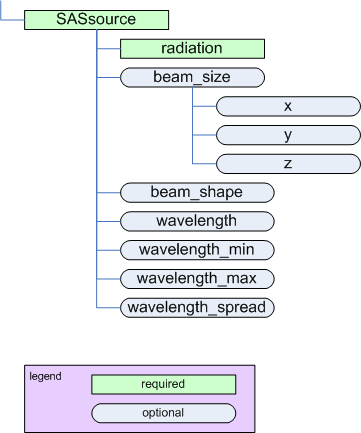Table Of Contents
Previous topic
Next topic
This Page
Quick search
Enter search terms or a module, class or function name.

The SASsource element
| Name | Type | Occurrence | Description | Attributes |
|---|---|---|---|---|
| radiation | string | [1..1] | Name of the radiation used. For maximum compatibility with NeXus, use one of the types defined by NeXus NXsource: [1]
or the NeXus probe type:
|
|
| beam_size | container | [0..1] | Physical dimension of the beam (incident on the sample). If beam is round, just use X dimension. | name={name} [2] |
| beam_shape | string | [0..1] | Text description of the shape of the beam (incident on the sample). | |
| wavelength | float | [0..1] | wavelength (\(\lambda\)) of radiation incident on the sample. | unit={unit} [3] |
| wavelength_min | float | [0..1] | Some facilities specify wavelength using a range. The minimum of such a range is given by* wavelength_min*. | unit={unit} [3] |
| wavelength_max | float | [0..1] | Some facilities specify wavelength using a range. The maximum of such a range is given by* wavelength_max*. | unit={unit} [3] |
| wavelength_spread | float | [0..1] | Some facilities specify the width of the wavelength spectrum. The width of such a range is given by wavelength_spread. | unit={unit} [3] |
See the figures in Definition of the coordinate axes.
| Name | Type | Occurrence | Description | Attributes |
|---|---|---|---|---|
| \(x\) | float | [0..1] | Dimension of the beam in X. | unit={unit} [3] |
| \(y\) | float | [0..1] | Dimension of the beam in Y. | unit={unit} [3] |
| \(z\) | float | [0..1] | Dimension of the beam in Z. | unit={unit} [2] [3] |
Table Notes
| [1] | NeXus NXsource: http://download.nexusformat.org/doc/html/ClassDefinitions-Base.html#NXsource |
| [2] | (1, 2) While \(z\) is allowed by the standard (provided by use of a standard size element in the XML Schema), it does not make sense to use it for small-angle scattering in some situations as noted. Use of \(z\) in such situations may be ignored by processing software. |
| [3] | (1, 2, 3, 4, 5, 6, 7) The unit attribute is required. See Rules for acceptable values. |